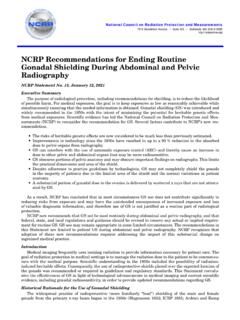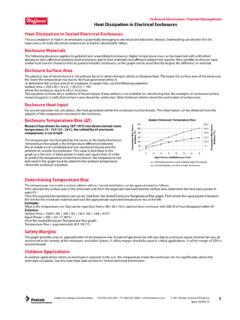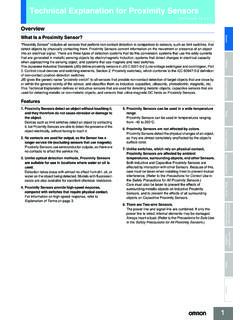Transcription of Technetium - 99m - University of Michigan
1 Technetium - 99m Data Sheet Page 1 of 4 Revision Date: 09/20/18 Technetium - 99m Radiological Safety Guidance Revision Date: 09/20/18 Physical Data GAMMA ENERGIES keV ( abundance) keV ( ) keV ( ) No beta particles emitted by Tc-99m Specific Gamma Ray Constant mrem/h at 1 meter per 1 mCi, or 760 mrem/h at 1 cm per 1 mCi Physical Half-Life hours Biological Half-Life hours Effective Half-Life hours Specific Activity 5,243,820 curies/gram ("carrier free"/pure Tc-99m) x 106 curies/gram (99m Tc-pertechnetate form) Shielding lead shielding is adequate for Tc-99m 140 keV gammas SHIELDING THICKNESS Half-Value Layer (HVL/Lead) cm = in (140 keV) Half-Value Layer (HVL/Water or Tissue) cm = in Tenth-Value Layer (TVL/Lead) cm = in (140 keV) Tenth-Value Layer (TVL/Concrete) cm = in Attenuation Coefficient (100) cm = in (lead) Attenuation Coefficient (1000)
2 Cm = in (lead) Volatility Inherent Volatility (STP): Insignificant/Negligible Technetium - 99m Data Sheet Page 2 of 4 Revision Date: 09/20/18 Exposure: Radiological Safety Information Technetium -99m, in the form of sodium pertechnetate (Na99mTcO4), is easily obtained from a 99Mo-99mTc ("molly") generator. Typical dose administered is 10 mCi via ingestion (GI Tract Stomach Wall: 51 mrem/mCi, Thyroid: 1300 mrem/mCi, Upper Large Intestine Wall: 120 mrem/mCi). Imaging time is typically 30-minutes after administration. Moly-generators are generally replaced weekly in the UMH Nuclear Pharmacy. Technetium -99m pertechnetate (99mTc04) is obtained directly from the "molly" generator using saline as the eluting solution. This radiopharmaceutical is used for brain, thyroid, salivary gland, and stomach scanning.
3 Typical adult dose is 15 millicuries. Separation of daughter Tc-99m from parent Mo-99 is usually accomplished by eluting a moly-generator with sterile normal saline solution. Tc-99m Pertechnetate: brain, thyroid, stomach, salivary gland scans Tc-99m Sulfur Colloid: liver imaging (delivered intravenous dose: 1-8 mCi (3 mCi)/338 mrad/mCi/imaging time is 30-minutes after injection); spleen imaging (delivered intravenous dose: 1-8 mCi/213 mrad/mCi), and bone marrow scans (delivered intravenous dose: 3-12 mrem/mCi). Oral administration doses are generally 500 uCi. Tc-99m Macroaggregated Albumin (99mTc MAA): lung scans; typical administered dose is 3 mCi Tc99m/injection; imaging time is within 2-3 minutes; lung imaging dose (22 mrad/mCi). Exposure Rates Exposure rates from unshielded millicurie isotropic point source of Tc-99m: DISTANCE MILLIREM/HOUR cm cm cm in Exposure Prevention Always wear a lab coat and disposable gloves when handling Tc-99m.
4 Engineering Controls Drying can cause airborne Tc-99m dust contamination. Rapid boiling can cause airborne Tc-99m aerosol contamination. Expelling Tc-99m solutions through syringe needles and pipette tips can generate airborne aerosols. Personal Safety Tc-99m is used in clinical and research diagnostic scanning and imaging. Whole body and extremity exposures, skin contamination (dose), ingestion, inhalation, puncture/injection, absorption through skin, and area contamination are primary radiological safety concerns. Technetium - 99m Data Sheet Page 3 of 4 Revision Date: 09/20/18 Regulatory Compliance Limits (10 CFR 20/Appendix B) REGULATION UNIT OF MEASURE NOTES Derived Air Concentration (DAC) (Occupational) uCi/mL (Class "D") uCi/mL (Class "W") Airborne Effluent Release Limit (Annual Average) uCi/mL (Class "D") uCi/mL (Class "W") Applicable to the assessment and control of dose to the public (10 CFR ).
5 If this concentration was inhaled continuously for over one year the resulting TEDE would be 50 millirem Unrestricted Area Removable Contamination Limit 1,000 dpm/100 cm2 Container Labeling Quantity (10 CFR ) 1 mCi Annual Limit on Intake (ALI) 80 mCi (all compounds)* (oral ingestion/CEDE/Whole Body/5 rem) o ALI = 80 mCi ingested = 5,000 millirem CEDE/Whole Body * (all compounds, except oxides hydroxides, halides, and nitrates) 200 mCi (all compounds) (inhalation/CEDE/WB/5 rem/Class "D") 200 mCi (all compounds) (inhalation/CEDE/WB/5 rem/Class "W") o ALI = 200 mCi inhaled = 5,000 millirem CEDE/WB/Class "D" Contamination Radiological Data Critical Organ (Biological Destination)* Total Body Routes of Intake Ingestion Inhalation Puncture/Injection Would Skin Contamination (Absorption) External and internal exposure and contamination concerns Tc-99m Committed Dose Equivalent (CDE): (Organ Doses) mrem/uCi (puncture/thyroid/adult) mrem/uCi (ingestion/thyroid) mrem/uCi (inhalation/thyroid) Tc-99m Pertechnetate (99mTc04) - (MUGA Scans) behaves similar to iodine and concentrates in thyroid, salivary glands, brain, blood pool, urinary bladder, and stomach.
6 Stomach receives majority of dose and contains 25% of administered dose after 4 hours. Technetium - 99m Data Sheet Page 4 of 4 Revision Date: 09/20/18 Tc-99m-Labeled Sulfur Colloid - approximately 70-80% of the administered dose (3 mCi/injected) is localized in the liver. Used for liver, spleen, and bone-marrow scanning. Tc-99m-Labeled Macroaggregated Albumin (99mTc MAA) - primarily used for lung scanning; 90-95% of administered dose (3mCi/injected) is trapped in the capillary bed of the lungs within a few seconds after intravenous administration. Tc-99m (MUGA) - spleen receives approximately rad/mCi. Tc-99m (DTPA) - brain or kidney scan; administered dose is 20 mCi (injected); bladder ( rad/mCi); whole body (20 mrad/mCi) Skin Contamination (Tc-99m) Skin Contamination Dose Rate (Basal Cells): 718 millirad/hour per uCi/cm2 o Dose to basal cells at a depth of 7 mg/cm2 or cm in tissue without air reflection Skin Contamination Dose Rate (Extremity Skin): Negligible o Dose to skin of extremities at a tissue depth of 30-50 mg/cm2 of cm Detect Contamination Survey Instrumentation Monitor for removable surface contamination by smearing, swiping, swabbing, or wipe-testing where Tc-99m is used.
7 Count smears or swabs in a liquid scintillation counter (LSC), gas proportional counter (GPC), or a gamma counter. Monitor personnel, work areas, and floors using a survey meter equipped with a 1" x 1" or a low-energy NaI scintillation probe for Tc-99m contamination. A survey meter equipped with a G-M pancake/frisker probe ( cm2 surface area) can be used for the detection of gross Tc-99m contamination. Survey meter equipped with a 1 x 1 or a low-energy NaI scintillation probe is preferred for the detection of Tc-99m contamination. Typical counting efficiencies: [1 x 1 NaI probe (39%)] and [low-energy NaI probe (12%/Ludlum and 18%/Bicron)]. Survey meters equipped with a G-M pancake/frisker ( cm2 surface area) can be used; however, they exhibit very low counting efficiencies (approximately, ) for the detection of low-energy Tc-99m gamma rays.
8 G-M probes are only effective for gross Tc-99m contamination. Indirect counting using a liquid scintillation counter (LSC), gamma counter, or gas proportional counter (GPC) should be used to detect removable Tc-99m contamination on smears, swabs, or swipes. Required Personal Radiation Monitoring Dosimeters (Whole Body and Finger Tabs): Required when handling > millicurie of Tc-99m at any time.













